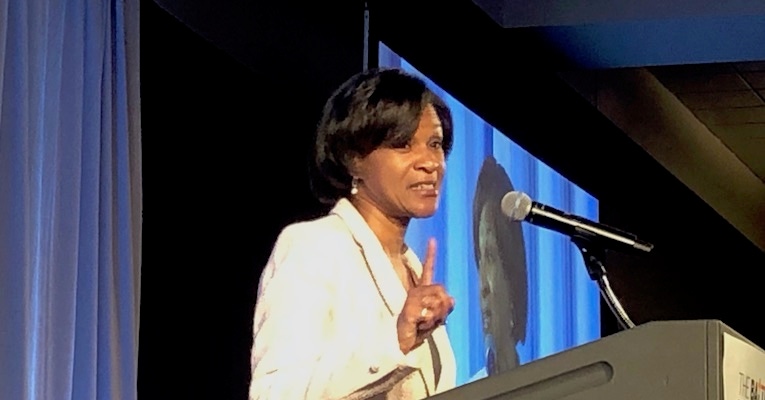One of the top battery executives gives us her thoughts on innovation, collaboration, and the future of the industry.
September 15, 2021

One of the advantages of listening to a top executive who is also an engineer is that they tend to have their thoughts well-organized and focused on the challenges at hand. Denise Gray has an engineering degree from Kettering University and a Master’s Degree from Rensselaer Polytechnic Institute and, following a 30-year career at General Motors is now the President of LG Energy Solution Michigan, Inc. Gray provided a Keynote Address at The Battery Show in Novi, Michigan on September 15.
Here are a few of the comments that Denise Gray made that we found particularly interesting:
The Battery Industry
“I get excited about batteries”
“Our industry has changed and it’s so exciting. So many companies have announced that their product line is really changing and moving toward battery electrics or plug-ins and for all of us, we should be like yay! We are getting there. “
“This industry of battery technology has to be flexible. It has to be agile. The technology that we had back in 2010 when I was at General Motors and we launched the first-generation Chevrolet Volt is different than the technology that we are launching today. And it must be different than the technology we are going to launch five years from now or ten years from now.”
“Please don’t box me into a format because we are only at the beginning. The technology has changed three times in 20 years—maybe 10 or 15 years.”
Costs
“Where are the costs going? I think our for 2020 was $125 ($ per kilowatt-hour), I think the target for 2025 is something around $85 per kilowatt-hour. Again those are targets—I did not say we are at those numbers. But I can clearly say we all have a laser focus on where we need to go in order to make this technology viable.”
“When I began in this industry, those costs were way over $1,000 per kilowatt-hour. Can you imagine where this technology has gone and how that cost curve has been attacked and worked on collectively for all these many years?”
“Trying to break even and make money in this industry has been tough. You’ve got to be in it for the long haul. There have been companies that have come. And there have been companies that have gone. So you have to have deep pockets to be able to self-fund as you make your way down the technology path.”
Plans For More Capacity
“Today, our plans for mid-2025 for example is to have at least 40 gigawatt-hours, maybe 70 gigawatt-hours here in the United States to service our customers. And that’s outside of the GM and LG collaboration Ultium, which has its own glide path for capacity for those vehicle lines, so we will have a lot of capacity here in the United States.”
Innovation
“For the innovators out there, what should you be working on? I want to give you those hints. That we are still trying to master how do you get fast charge, also still meet the life requirements, and also keep it at low cost.”
“I think we will be talking about those things until the end of time: How do we get more performance? How do we make sure that we keep the low cost? And how do we keep it low weight, because F still equals MA, and we have to make sure that we keep the mass down.”
“We do look at it as a dual path: the premium versus the value. When we go to talk to our customers, there is always going to be a premium, but there is going to be a value as well. Our portfolio kind of stretches out that way as we have listened to the voice of our customers, as we understand the technology balancing act when it comes to cost and performance.”
Collaboration
“We are collaborators when it comes to technology. We are always collaborating with start-up companies, with universities, and keep pushing everybody, keep pushing because I think the more people we have working in this industry, and (who) understand what the problem statement is, then I think that we will have more people providing us solutions. It’s going to continue to lift the technology when it comes to batteries.”
Future Technologists
“Where are we with growing our next technologists? Today we are revolutionizing the technology that’s in an automobile. When was the last time you reached out to a young lady or a young man, a newly minted engineer, and said, ‘Come on in to our industry because we have got some exciting things going.’”
“One of the downsides of what we do and how we are, what’s in our DNA is that we just put our heads down and get it done, right? But the problem is you are not telling others about what you are doing to bring them into the industry to be our next generation of electrochemists or algorithm controls engineer, or mechanical engineer, or mechatronics engineer, or whatever that engineer is. Every single one of us has an obligation to tell someone about the amazing industry that we have and to come on along and shadow us and be a part of us.”
Kevin Clemens is a Senior Editor with Battery Technology.
About the Author(s)
You May Also Like





